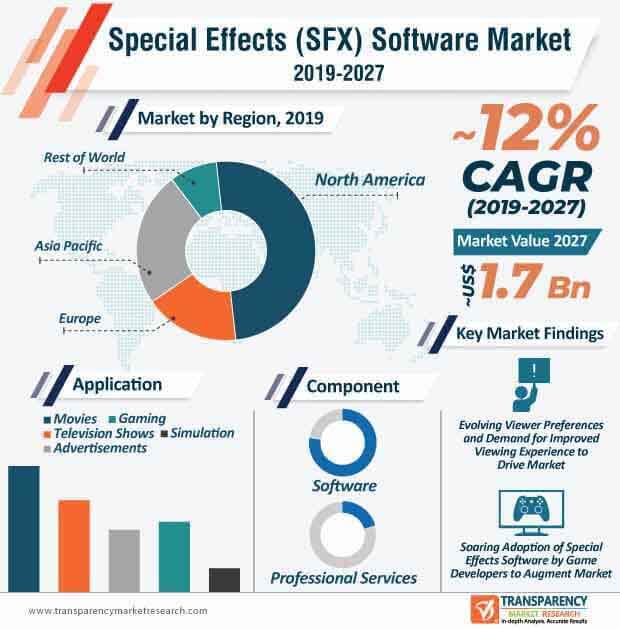
Digitalization coupled with rapid advancements in technology has played a key role in revolutionizing the entertainment sector. The advent of cloud services and growing adoption of the same for content creation over the past few years have come at a time when over-the-top content started becoming popular. The significant rise in the number of over-the-top content viewers and the number of viewing hours has brought about significant innovations in post-production stages due to which, the demand for special effects software has increased at an impressive rate– a factor that will augment the growth of the global special effects software market during the forecast period. From modest use of special effects in movies such as The Titanic, movies such as The Avengers feature special effects that were hard to achieve a couple of decades ago.
Evolving viewer demands for high-quality content coupled with soaring demand for top-notch audio-visual effects for an enhanced viewing experience has led to a rise in the adoption of special effect software in the past few years. In the current scenario, special effects software is increasingly being used in television series, advertisements, games, movies, and more– another factor that is projected to propel the growth of the special effects (SFX) software market in the coming years. These factors, along with the advent of new special effects (SFX) software with improved capabilities are expected to drive the global special effects (SFX) software market past the ~US$ 1.7 Bn mark by the end of 2027. Moreover, the dwindling cost of software tools used to develop content has increased the adoption of multiple special effects software in the past few years.

Request a sample to get extensive insights into the Special Effects (SFX) Software Market
Entry of Cloud-based Platforms to Redefine Special Effects (SFX) Software Market
When cloud computing made an entry into the entertainment space, its adoption increased across various studios on a project-to-project basis despite being largely confined to burst to render. However, due to lack of a concrete cloud-wide audit, vendors operating in the special effects (SFX) software market were unwilling to provide services beyond burst rendering. Some of the key areas such as virtual workstations and long-term storage were completely ignored during the initial phase of deployment of cloud-based platforms in the special effects (SFX) software market.
However, the formulation of Trusted Partner Network (TPN), which constitutes of top value content producers, MPAA member studios, and other stakeholders drafted a framework for vendors involved in the special effects (SFX) software market. At present, although cloud-based platforms are predominantly available for on-premise systems, the TPN audit for cloud will pave the way for media workflows for studios who are inclined toward the use of cloud for an array of different types of content creation projects, including virtual studio, hybrid rendering, and storage of material on the cloud.
To understand how our report can bring difference to your business strategy, Ask for a brochure
While on-premise software modules are currently in demand, cloud/SaaS-based software will gain noteworthy traction in the second half of the forecast period.
Gaming Industry Presents Lucrative Opportunities for Special Effects Software Vendors
While the deployment of special effects software in movies and television shows is expected to grow at an impressive pace during the forecast period, another major area of application wherein special effects software is likely to be deployed is gaming. The booming global gaming industry, which has entered the billion-dollar club presents a plethora of opportunities for companies operating in the current market for special effects (SFX) software. Due to the blazing pace at which gaming graphics have evolved in the past few years, the entry of special effects in the gaming space was inevitable. Moreover, the advent of novel technologies such as augmented reality and virtual reality, motion capture, and real-time rendering has enabled advanced simulations and imaging. Gaming companies are increasingly deploying advanced special effects (SFX) software to improve the overall gameplay of their games and improve the overall gaming experience of their customers. Thus, technological advancements and growing adoption of special effect software are expected to revolutionize game development models in the coming years. At present, special effect software is playing a key role in transforming the visuals of games and the trend is set to continue during the forecast period. This is expected to drive the global special effects (SFX) software market during the forecast period.
Read Our Latest Press Release:





